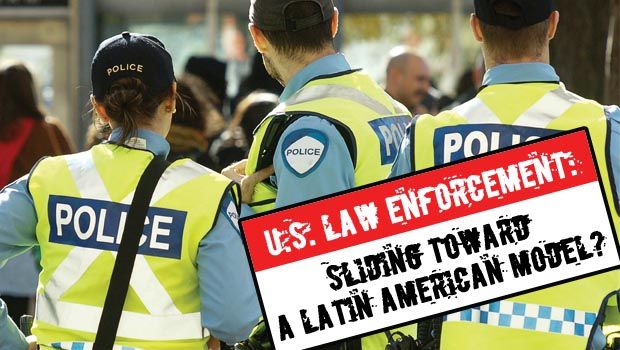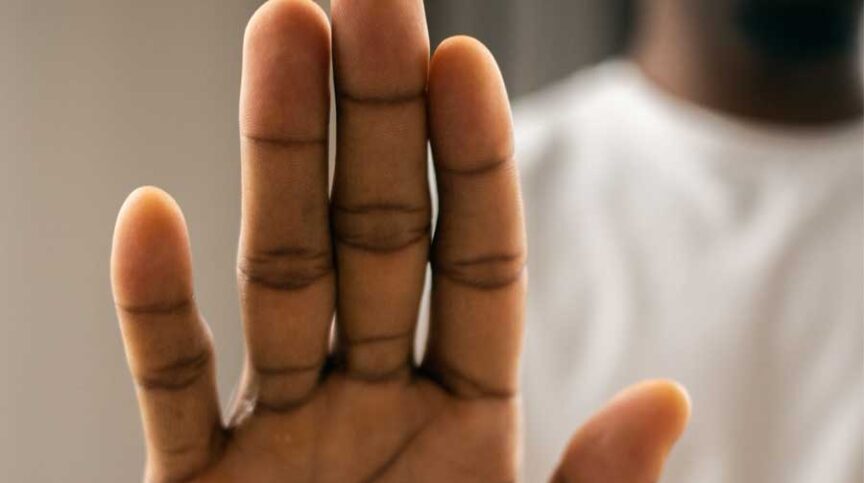The ongoing events in Ferguson, Missouri after the killing of Michael Brown by police officer Darren Wilson, has brought to light the issue of militarization of the police in the United States. A number of federal programs make it easy for state and local law enforcement agencies to acquire surplus military equipment from the Department of Defense. When police departments, large and small, end up with M-16 rifles, silencers, ammunition magazines, grenade launchers, camouflage and night-vision equipment, armored cars and aircraft, there is a corresponding inclination to use these instruments of war. There is also a corresponding tendency for police officers to start looking at the public as potential enemies rather than citizens they are sworn to protect. The ACLU has found that SWAT team raids on people’s homes for common law enforcement purposes are increasing. In a report, “War Comes Home: The Excessive Militarization of American Policing,” they found that almost 80 percent of the paramilitary raids they examined were for for ordinary law enforcement, not emergencies.
It is a critical challenge for the Americans to demand that young men of color stop being shot by law enforcement without the exercise of proper restraint, betraying the oath they have sworn to
Cosme Caal, a Mayan whose family is originally from Guatemala but came to the U.S. in the 1980s, now lives in Guatemala City and wrote an article in August of this year while observing the events in Ferguson: “From our experience in half a century in Latin America I can tell you that, once the human rights of a minority are compromised, it is only a matter of time before they are compromised for an entire nation. From that same experience I can tell you it will take decades before they can be regained. Militarized police forces take on a life of their own, at the expense of the society’s well-being. The social contract that gives the state the duty to organize police forces itself becomes obsolete, almost a joke. Citizens begin to obey agents of the state not out of respect or cooperation, but out of fear of those sworn to protect them. Eventually, the militarized power of the police reaches such magnitude that political leaders lose all ability to reign them in. We experienced this U.S.-backed militarized transformation of the police in Guatemala, El Salvador, Honduras, Chile, and Colombia. What the U.S. helped do to Latin America, it is now doing to itself.”1
Militarized Transformation of Police in Guatemala
The “U.S.-backed militarized transformation of the police in Guatemala, El Salvador, Honduras, Chile, and Columbia” that Caal refers to is well documented and in some cases, like that of Guatemala, top-secret government documents have been declassified and reveal conclusively the involvement of the CIA.
Guatemala is a case in point about human rights abuses that are perpetrated in a militarized State and is worthwhile examining here.
After decades of suffering at the hands of autocrats, including that of General Jorge Ubico whose fourteen year regime was supported by the U.S., Guatemalans began organizing for change and in 1944 Ubico resigned. Juan Jose Arevalo became president in Gautemala’s first democratic election and instituted some reforms. Then Jacobo Arbenz came to power in 1950, also in a democratic election. He promised reforms to help the poor as there was a great divide between the vast majority who lived in dire poverty and the elites whose power and wealth were guarded by the military juntas that had ruled for so long. Once Arbenz started instituting land and labor reforms, the United Fruit Company, an American corporation (which later, in 1984, became Chiquita), lobbied the U.S. government to do something to get rid of Arbenz. UFCO owned 42 percent of the most fertile land as General Ubico had rewarded them generously in return for support from the U.S. for his regime. Ubico’s regime also exempted the company from paying taxes and import duties. UFCO feared the reforms to labor laws as well, which included instituting a minimum wage, as the end of cheap labor would threaten their profits.
The CIA orchestrated a coup and Arbenz was forced to go into exile in 1954. Declassified documents published by the US National Security Archive at George Washington University reveal that the coup, codenamed PBSUCCESS, was part of a plan that included “subversion” and “psychological warfare and political action” intended to oust the government of Arbenz. Until the time that Arbenz went into exile, the option of assassination was on the table.2
General Carlos Castillo Armas was installed as the head of the military regime that ruled for the next three years, with various military strongmen to follow. Decades of civil unrest was set in motion after the U.S.-backed coup, and 200,000 Guatemalan people were killed, tortured, or forcibly disappeared at the hands of the military and paramilitary police units. The people were looked upon as insurgents to be put down at all costs. “Of those victims identified in the U.N. Historical Clarification Commission, 83% were indigenous Maya. 93% of these human rights violations were carried out by government forces.”3 According to Human Rights Watch, the military was guilty of “the rape of captured women, the brutal beating of infants, burying thousands of villagers alive, burning villagers alive, dismembering limbs, mutilating genitalia, and cutting off noses on living victims.” 4
After year after year of such atrocities and thoroughgoing repression by government forces in Guatemala, citizens of that country would risk a lot to escape from what many are calling a failed state. During the summer we heard of scores of children from Guatemala, Honduras and El Salvador coming through Mexico to try and enter the U.S. There were few media outlets or commentators who provided historical background to this “border crisis.” Many Americans know that the U.S. has intervened time and again in the internal affairs of numerous Latin American nations, but few know the full extent of those interventions. These included support of repressive regimes; a CIA-backed or orchestrated coup de e’tat when a leader intended reforms to benefit that country’s citizens which in some way threatened American business or national interests; and training of Latin American military personnel in repressive practices through the School of the Americas (SOA; now called the Western Hemisphere Institute for Security Cooperation). These interventions were used to maintain control of countries where raw materials and cheap labor profited American corporations, private investors, and domestic elites. In addition, the fight against the spread of communism during the Cold War was used to justify many of the actions taken by the U.S. and the CIA.
Training in Repression at the School of the Americas
Some of the worst human rights abuses in Latin America have been committed by graduates of the SOA/WHINSEC, throughout the 20th century and through to the present. Since its founding in 1946, the SOA has trained more than 64,000 personnel from Latin America. Major Joseph Blair, (Ret.), a military officer who specialized in Latin America and was awarded the Bronze Star and five Meritorious Medals, was an instructor at the SOA from 1986 to 1989. He says that “The doctrine that was taught was that if you want information you use physical abuse, false imprisonment, threats to family members, and killing. If you can’t get the information you want, if you can’t get that person to shut up or stop what they’re doing, you assassinate them—and you assassinate them with one of your death squads.” 5
Bill Quigley, a law professor and Director of the Stuart H. Smith Law Clinic and Center for Social Justice at Loyola University New Orleans, states in a report titled The Case for Closing the School of the Americas, “[G]raduates of the SOA have been implicated in many of the worst human rights atrocities in the Western Hemisphere, including the assassination of Catholic bishops, labor leaders, women and children, priests, nuns, and community workers and the massacres of entire communities.” He says that the SOA’s curriculum includes the “systematic use of torture and executions to neutralize dissidents.” The targets of the repressive tactics that included beatings, false imprisonment, and extrajudicial killings were “religious workers, labor organizers, student groups and others in sympathy with the cause of the poor.” In a story in the Washington Post in 2011, investigative journalist Dana Priest wrote, “Used in courses at the US Army’s School of the Americas, the manual says that to recruit and control informants, counterintelligence agents could use ‘fear, payment of bounties for enemy dead, beatings, false imprisonment, executions and the use of truth serum’, according to a secret Defense Department summary of the manuals compiled during a 1992 investigation of the instructional material…”6
Many of the Latin American countries where the U.S. has supported dictatorial regimes, or orchestrated, supported, or did nothing to stop a coup de e’tat, or trained military personnel in repressive practices at the SOA, are today places of ongoing civil unrest. These are countries, like Guatemala, which are dominated by violence not only from soldiers and police, but also from gangs and drug cartels. In a 2014 article written during the time that children were coming to the southern border in droves in attempts to enter the U.S., author Saul Elbein wrote that Guatemala today is a place of “men with guns who do what they want and take what they want. Your options are to buy your own security and gunmen [to protect you]; to join a gang yourself; or to leave.” 7
Militarization of Police in the U.S.
Echoing Cosme Caal’s warning that “what the U.S. helped do to Latin America, it is now doing to itself,” many Americans are concerned with what clearly looks like a militarization of the police. As mentioned previously, SWAT team raids on people’s homes for common law enforcement purposes are increasing with close to 80 percent for ordinary law enforcement purposes. According to the Rutherford Institute, a nonprofit civil liberties organization, “[I]n 1980, there were roughly 3,000 SWAT team-style raids in the US. By 2001, that number had grown to 45,000 and has since swelled to more than 80,000 SWAT team raids per year. On an average day in America, over 100 Americans have their homes raided by SWAT teams.” Fifty percent of those targeted by SWAT raids are African-American or Latino.9 In one tragic case, a SWAT team broke down the front door of a house in Habersham County, Georgia, and threw a flash bang grenade into the room. A 19-month-old child, Bounkham Phonesavanh, was asleep in the living room and the grenade landed in his crib, “blowing a hole in his face and chest that took months to heal and covering his entire body with scars,” as described by his mother. She says that doctors have told her that her son’s medical prognosis is good but that he will have to have “double reconstructive surgeries twice a year, every year for the next 20 years.” The SWAT team was looking for a relative of the family who did not even live in the house. A grand jury has not brought an indictment against any of the officers involved.
Other elements of excessive suspicion and inordinate and needless response to everyday occurrences and minor infractions of the law include the case of David Eckert, stopped in New Mexico in 2013 for a minor traffic violation. Police say they suspected him of carrying drugs in his anus because they thought he was clenching his buttocks when he was ordered out of his car. He was transported to Gila Regional Medical Center where doctors performed, despite Eckert’s protests, two rectal finger examinations, three enemas, and a colonoscopy. No drugs were found. Another case in New Mexico involved Albuquerque police shooting a mentally disturbed homeless man, James Boyd, in the back, killing him. He had been camping illegally on the outskirts of Albuquerque because the homeless shelters had closed. There was also the case of the 51-year-old homeless woman, Marlene Pinnock, who was punched repeatedly by a highway patrol officer in California, witnessed by many as it happened on the side of the freeway. According to law enforcement, Pinnock had ignored commands to stop as officers tried to prevent her from walking into traffic. They also say she was combative. The video nonetheless shows the officer pummeling her over and over again while she is on the ground. These police brutality/excessive force cases are disturbing, and the majority involve African-Americans and Latinos. The list of these incidents goes on and on.
Another example of out-of-control police action is the increasing number of people who are stopped for alleged traffic violations and then asked if they are carrying any cash, only to have that cash seized by the officer even though they are guilty of nothing and are not charged with a crime.10 Civil rights lawyers contend that this practice is nothing but highway robbery. A federal class-action suit has been filed in Texas to try to bring to an end this burgeoning “stop and seize” practice by law enforcement. The suit charges that officers are targeting non-white drivers. And some critics see the seizures as a way for police departments to enlarge their operating budgets.11
Recruitment, Control, and Betrayal of Informants
Another significant area of concern are the practices used by the FBI, sometimes in conjunction with a local police department, to recruit informants in the fight against terrorism. The use of this practice by the FBI is well-known and has been shown to involve potential human rights abuses. Human Rights Watch and Columbia Law School’s Human Rights Institute issued a 214-page report, “Illusion of Justice: Human Rights Abuses in US Terrorism Prosecutions.” The report documents how the recruitment and use of informants too often ends up encouraging and facilitating the very terror acts they intended to prevent. The report states, “In some cases the FBI may have created terrorists out of law-abiding individuals by suggesting the idea of taking terrorist action or encouraging the target to act.” The NYPD notoriously worked to recruit informants to spy on fellow Muslims. The use of informants is problematic, “often targeting particularly vulnerable individuals (including people with intellectual and mental disabilities and the indigent), in which the government—often acting through informants—is actively involved in developing the plot, persuading and sometimes pressuring the target to participate, and providing the resources to carry it out.” Co-author of the report, Andrea Prarsow, who is a deputy director at Human Rights Watch, says that of the 27 federal terrorism cases the researchers looked at shows “that many of these people would never have committed a crime if not for law enforcement encouraging, pressuring, and sometimes paying them to commit terrorist acts.” 12
In the Washington Post story by Dana Priest mentioned above, she quotes the manual used at the School of the Americas which instructs counterintelligence agents in the use of “fear, payment of bounties for enemy dead, beatings, false imprisonment, executions and the use of truth serum” in their recruitment and handling of informants. That training is intended for military personnel from Latin American countries. That is morally repugnant enough. But some of those techniques are used unfortunately in this country including the use of generalized fear, threat of false imprisonment, and payments for the recruiting and controlling of informants. One very disturbing case is that of Ayyub Abdul-Alim of Springfield, Massachusetts. Abdul-Alim is a 36-year-old Muslim of African-American and Puerto Rican descent. In 2010, upon returning from a three-week trip to Mecca, he got a call from an FBI agent in the Springfield office, James Hisgen, who tried to recruit him as an informant. Abdul-Alim refused the offer. The following year Abdul-Alim was arrested outside his apartment and in April of this year was convicted of illegal possession of a firearm. Abdul-Alim insists that the officers planted the gun on him. Seeming to bolster his claim is that two days after his arrest, FBI agent James Higsen and a Springfield police officer visited Abdul-Alim and offered to clear him of any charges if he agreed to become an informant. Again, he refused to cooperate. At some point his wife, Siham Stewart, had herself become an informant and it is alleged that she received close to $12,000 in payments from the FBI. She testified against Abdul-Alim at the trial and admitted to working as an informant. Abdul-Alim was sentenced to four to six years in state prison after being found guilty of possession of a firearm and ammunition without a firearms identification card, despite his claims to being set up as a means to pressure him into becoming an informant.
Informants have been routinely used for years, especially by drug enforcement agents. According to a 2012 article in The New Yorker Magazine about Rachel Hoffman, “Every day, offenders are sent out to perform high-risk police operations with few legal protections. Some are juveniles, occasionally as young as fourteen or fifteen. Some operate through the haze of addiction; others, like Hoffman, are enrolled in state-mandated treatment programs that prohibit their association with illegal drugs of any kind. Many have been given false assurances by the police, used without regard for their safety, and treated as disposable pawns of the criminal-justice system.” Indeed, 23-year-old Rachel Hoffman was one of the “throwaways” who in 2008 was arrested for a possession of drugs including marijuana and Valium which were found in her apartment after a neighbor called police complaining about the smell of marijuana. Hoffman was subsequently offered a deal whereby if she provided “substantial assistance” to the Tallahassee, Florida narcotics team, the charges against her could be reduced or dropped. Hoffman, called by her handlers Confidential Informant No. 1129, or C.I. Hoffman, was sent on an undercover assignment to buy cocaine, Ecstasy pills, and a semi-automatic gun from two convicted felons. The nineteen agents who were tracking her lost contact and she disappeared. Two days later her body was found fifty miles away. She had been shot five times with the gun she had been sent to buy from the felons.
The Israeli Model – A Contributing Factor to Militarization
Once a nation trends toward militarization of its police, as described above by Caal, that inclining can easily become a runaway train. Some observers and commentators have noted a factor they believe is greasing the wheels of that train in the U.S. – the Israeli homeland security industry. That industry promotes itself as being able to provide cutting edge training and technology in security solutions. In a recent article in the Jerusalem Post by Avi Dichter, former director of the Shin Bet (Israel’s security agency), we are told that “Israeli security systems protect some of the major symbols of western civilization, including the Vatican, and the Eiffel Tower. These systems also secure some of the largest aviation hubs and seaports, including JFK (New York City), Heathrow (London), and Changi (Singapore) airports. Furthermore, Israeli trainers support police and counter-terror units around the globe.”13 He mentions that in November, the 3rd International Conference for Homeland Security will be held in Israel and “dozens of Homeland Security Ministers, Police Chiefs, Mayors and business executive from across the globe” are expected to attend.
Increasing numbers of U.S. police officials have trained in Israel as part of collaborative programs aimed at teaching local, state, and federal law enforcement about counter-terror strategies and policing practices, including crowd control. Officials from large cities such as Los Angeles and New York have received such training, as well as St. Louis County police chief Tim Fitch who trained in Israel in 2011.14 Along with other officials, Fitch attended the National Counter-Terrorism Seminar (NCTS) which was sponsored by the Anti-Defamation League (ADL). An ADL press release about the training noted, “NCTS enables Israel’s counterterrorism experts to share their knowledge and lessons learned, to help American law enforcement better protect America, and prevent us from having to learn the same lessons the hard way.” The press release mentions that officials attending included those “from the California Highway Patrol and major city police departments from across the country including: New York, Philadelphia, Houston, Dallas, Atlantic City, Louisville, Richmond, Tulsa, Nashville, Charlotte, Albuquerque, and St. Louis County.” 15
American Style Militarization – The Homegrown Factor
While the argument about the Israelization of police departments has traction, we should not forget that the U.S. has a long history of providing training in the militarization of police through the School of the Americas. In addition, heavy-handed policing in the U.S. itself goes back decades. Mark Levine, professor of modern Middle Eastern history at the University of California at Irvine, writes in an article in Al-Jazeera English, “The militarization of police and the concomitant view that treats minority communities as enemies needing to be pacified rather than citizens to be served professionally, began in the 1960s with the confluence of four factors.” He lists the assertiveness of the civil rights movement, counterinsurgency tactics that were used by the military in Vietnam being used in domestic urban settings and against the anti-war movement, the government response to the labor rights movement of the 1960s, and the war on drugs as begun by Nixon in 1971. 16
The Critical Challenge
Whatever the factors are that contribute to the militarization of the police in this country, it is a critical challenge for the American people to demand that young men of color stop being shot, even when they are unarmed, killed on the spot by law enforcement without the exercise of proper restraint, betraying the oath they have sworn to. We are challenged to speak up so as to apply the brakes to the runaway train of militarization. We must feel the challenge deeply in order to stand up for justice, not only for those who are subjected to police excess or brutality in our own country, but for the people of Latin America and the Middle East and the world over who are subjected to repression and the warrior cops who enforce the moral and criminal malfeasance of the State. When an entrenched autocracy or oligarchy is challenged, anyone can become a target – religious leaders, labor organizers, women and children, community workers, student groups, social justice advocates for the poor and disenfranchised, indigenous peoples who are denied their rights, and the list goes on and on.
The challenge calls to us all, eerily echoing along the paths of vulnerable children trying to escape the poverty and violence of Latin American countries held in the vice grip of autocracy. The challenge reverberates through the multitudes of protestors in Ferguson marching with arms interlocked or chanting “Hands up, don’t shoot!” And the challenge thunders with unmistakable urgency and imperative among the Palestinian people who day by harrowing day, 75 years in the making, struggle to throw off the stranglehold of colonizing land confiscation, all-pervasive discrimination, and brutal occupation – just to rightfully claim their human and civil rights under international law and the Geneva Conventions.
“O you who believe! Stand up firmly for justice, as witnesses for the sake of God, even if it be against yourselves or your parents or your kin; and whether it concerns the rich or poor, for God can best protect both. Follow not your desires, lest you swerve, and if you distort justice or decline to do justice, verily God is well-acquainted with all that you do” (Qur’an 4:135).
http://www.counterpunch.org/2014/08/27/the-latin-americanization-of-u-s-police-forces/
http://www2.gwu.edu/~nsarchiv/NSAEBB/NSAEBB4/
http://www.cja.org/article.php?list=type&type=294
http://www.fhrg.org/news/human-rights-in-guatemala.htm
http://www.salon.com/2014/03/08/35_countries_the_u_s_has_backed_international_crime_partner/
http://jfk.hood.edu/Collection/Weisberg%20Subject%20Index%20Files/T%20Disk/Tiger%20to%20Ride%20Tiger%20File%20Part%202/Item%2044.pdf
http://www.newrepublic.com/article/118675/child-migrants-guatemala-are-fleeing-more-just-gang-violence
https://www.rutherford.org/publications_resources/john_whiteheads_commentary/are_police_in_america_now_a_military_occupying_force
https://www.aclu.org/sites/default/files/assets/jus14-warcomeshome-report-web-rel1.pdf
http://www.chicagotribune.com/news/nationworld/chi-texas-profiling_wittmar10-story.html#page=1
http://www.chicagotribune.com/news/nationworld/chi-texas-profiling_wittmar10-story.html#page=1
http://www.hrw.org/reports/2014/07/21/illusion-justice-0
http://www.jpost.com/Opinion/The-Israeli-homeland-security-industry-378908
http://www.stltoday.com/news/local/metro/article_9b614430-5679-11e0-999b-0017a4a78c22.html
http://www.adl.org/press-center/press-releases/israel-middle-east/american-law-enforcement-1.html#.U-3JpvldWuI
http://america.aljazeera.com/opinions/2014/8/ferguson-police-violenceisraeliandusmilitarizedpolicies.html





